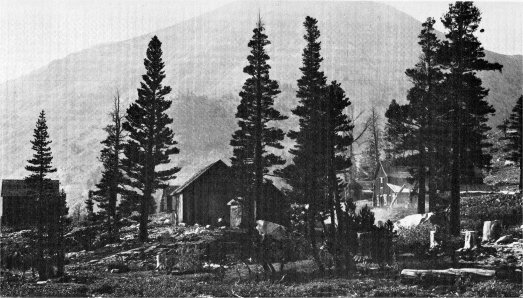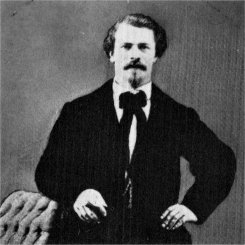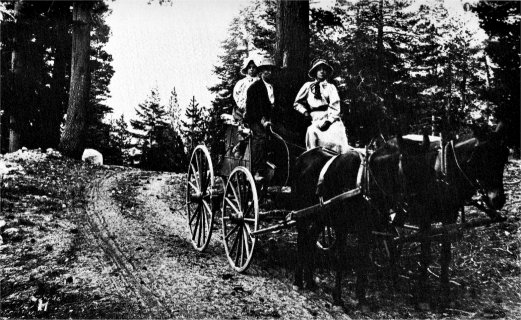
[click to enlarge]
At the end of the Great Sierra Wagon Road, Bennettville, 1898
| Online Library: | Title | Author | California | Geology | History | Indians | Muir | Mountaineering | Nature | Management |
Yosemite > Library > Tioga Road > The Great Sierra Wagon Road >
Next: Before 1915 • Contents • Previous: Mines
Expectations of success and needs for large quantities of supplies coupled with the near disaster of hauling mining machinery over the snow led the Great Sierra Board of Directors to consider the building of a wagon road to the mines. Although trail routes had been established to the eastern railroads via Lundy and Bloody Canyon, the new road was to cross the Sierra from the west with goods to be hauled from the railhead at

[click to enlarge] At the end of the Great Sierra Wagon Road, Bennettville, 1898 |
In the fall of 1882 the company gave the go-ahead and Charles N. Barney was assigned as engineer with William C. Priest as his assistant. Both the survey and construction began at once. H. B. Carpenter and H. P. Medlicott conducted the road (and railroad) survey with a Mr. Hall and John V. Ferretti as chainmen. In addition to making the road survey the group was picking a line for a railroad “to make the shortest and most direct route from the east to San Francisco.” Years later the pass was considered for part of the Union Pacific route. (23)
In July of 1882 the California and Yosemite Short Line Railroad had been incorporated in Sacramento to run from Modesto to Mono Valley via “old Lee Vining Creek or McLean Pass” with its “Principal place of business, Bennettsville, Tioga Mining District.” J. C. Kemp Van Eee, C. W. Curtis, O. H. Brooks and R. W. Woolard, all of the Great Sierra Consolidated Silver Co., organized the company with $5 million capital stock with $250,000 actually subscribed. California and Yosemite Short Line Railroad monies provided supplies, via Lundy, for the survey crew. (28)
The survey party advanced to White Wolf before snowfall. Work was resumed the spring of ’82, and Tioga Pass was reached in July. The Bodie Daily Free Press noted that “Engineer Carpenter’s . . . survey (was completed) for the California and Yosemite Short Line Railroad from McLean’s Pass . . . to Mono Lake Valley” on July 20. (19) In August the Free Press commented on the fate of Tuolumne Meadows’ hospitable hermit, John Lembert: “Now, however, the spirit of civilization in the person of John L. Ginn, Chief Engineer of the Yosemite Short Line Railroad, has planted the survey stakes of a railroad line within a hundred feet of the hermit’s door, and it is a mere matter of time when his lonely reveries will be broken by the shrill whistle of the locomotive.” (20) Chainman John Ferretti recalls meeting John Lembert who was living in a hut that to him “looked more like a bear trap than a place for human habitation” over Soda Springs. Ferretti was somewhat awed by the hermit but found him friendly, though saddened by the advent of the road.
Another incident recalled by Ferretti

[click to enlarge] John V. Ferretti |
After completing the survey through Tioga Pass, the surveyors tied in the mine locations and disbanded. John Ferretti joined the construction gang as a blacksmith’s helper and general roustabout. His pay was augmented by pies, cakes and cookies slipped to him by Sing Lee, the camp cook. John’s final act on the job included splitting his big toe with an axe. The “first aid man” applied “a large chew of tobacco, took a rag and tied it up, guaranteeing that it would be as good as new in a few days. At that moment . . . I severed my connection with the Tioga Road for all time.” (21)
Construction progressed at an awesome rate. Nearly one-half mile of finished road was turned out by the 160 man crew for each day on the job. (22) The fall of ’82 saw the road advance from Crocker’s to as far as the present park boundary, about two miles. (21) On April 27, 1883 work was resumed and it was carried forward without interruption or accident until finally completed September 4th, 1883.” In 130 days the 56 1/4 mile stretch was completed at a cost of $61,095.22, or about $1,100 per mile.
From the columns of the August 11 Homer Mining Index we learn of construction progress and methods. “The Great Sierra Wagon Road is rapidly approaching completion. Harry Medlicott’s graders from this side have reached the upper end of Tuolumne Meadows, while Priest’s pick and shovel brigade from the other side are on Rocky Canyon Creek, leaving a gap between of little more than three miles, all of which is easy grading. Priest’s powder gang, following the picks and shovels, reached Lake Tenaya Thursday and will skip the heavy blasting along the margin of the lake for the present and follow up to the Tuolumne River, after which one hundred blasters will be put on to finish the three-fourths of a mile along the lake. It is believed that freight wagons will reach Tioga by or before the end of the month. The construction of this road was a stupendous and costly undertaking and the Eastern capitalists to whose enterprise and public spirit the people of this county and coast are indebted for a great thoroughfare to a hitherto inaccessible but rich and extensive region, deserve to be remembered with gratitude.”
According to one report (24) there were 90 white men and 250 Chinese in the employ of the company. Another alludes to 250 men (21) and a third a 160 man crew of Chinese. We are certain that at least 35 Chinese were at work on the Tioga Road in ’83 as a receipt for their hospital tax, paid for by the Road company, is part of the Yosemite Museum collections (26). Pay rates were phenomenal: the Chinese received $1.20 per day, the Caucasians $1.50 (25) The foreman, James Lumsden of Big Oak Flat, was most pleased when his wage was advanced from $1.75 to $2.00 per day in recognition of his making “changes of his own accord which the surveyors afterwards said were more practical.” In addition all hands were supplied with excellent board. (24)

[click to enlarge] On the Tioga Road. about 1890 |
Soon after the Great Sierra Wagon Road was completed, “a big jollification was held in Sonora” with many prominent men of the day in attendance. (24) The road was built!
Next: Before 1915 • Contents • Previous: Mines
| Online Library: | Title | Author | California | Geology | History | Indians | Muir | Mountaineering | Nature | Management |
http://www.yosemite.ca.us/library/tioga_road/great_sierra_wagon_road.html